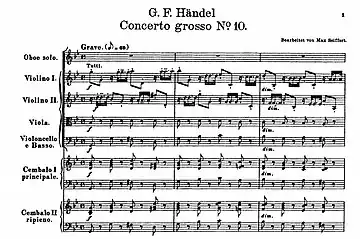
The beginning of the concerto.
The Oboe Concerto No. 3 in G minor (HWV 287) was composed by George Frideric Handel for oboe, orchestra and basso continuo, possibly in 1704-1705,[1] when he was still in Hamburg. It was first published in Leipzig in 1863 (from unknown sources) in which it was described as a work from 1703. No other source for the work is known. Other catalogues of Handel's music have referred to the work as HG xxi, 100; and HHA iv/12,3.[2]
A typical performance of the work takes around ten minutes.
Movements
The work consists of four movements:
- Grave. A characteristically dotted rhythm in French style.
- Allegro.
- Largo. A sarabande.
- Allegro. Thematically derived from the first movement, a sprightly piece with dialogue between the solo oboe and the accompanying instruments.
See also
References
- ↑ Blair Johnston, Oboe Concerto in G minor (No.3), HWV 287 (possibly spurious)
- ↑ Hicks, Anthony (2001). "Handel, George Frideric". In Sadie, Stanley; Tyrrell, John (eds.). The New Grove Dictionary of Music and Musicians. Vol. x (2nd ed.). London: Macmillan. p. 797.
Note: the Grove 2001 edition incorrectly marks this concerto as HWV 303.
This article is issued from Wikipedia. The text is licensed under Creative Commons - Attribution - Sharealike. Additional terms may apply for the media files.